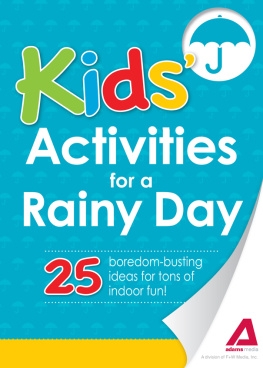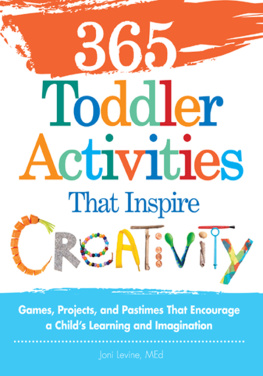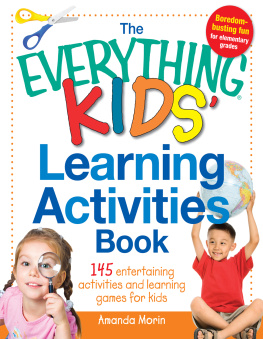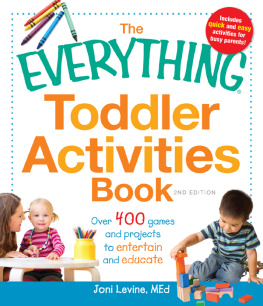Introduction
If I Had My Child to Raise Over Again
If I had my child to raise over again,
Id fingerpaint more and point the finger less.
Id do less correcting and more connecting.
Id take my eyes off my watch, and watch with my eyes.
I would care to know less and know to care more.
Id take more hikes and fly more kites.
Id stop playing serious, and seriously play.
Id run through more fields and gaze at more stars.
Id do more hugging and less tugging.
I would be firm less often, and affirm much more.
Id build self-esteem first, and the house later.
Id teach less about the love of power, and more about the power of love.
Diane Loomans
Although coping with the needs of a baby can be tough for new parents, it usually doesnt take long for most to feel comfortable with changing, feeding, holding, and rocking their infants. As babies grow into toddlers, most parents are able to cope with wiping noses and behinds, making meals no one eats, finding toys and clothes and sticky finger marks everywhere, and, of course, doing laundry, laundry, laundry. But as children leave the toddler stage and become full-fledged preschoolers, their needs change dramatically. Few parents feel prepared to meet the daily demands of life with a preschooler, and most find it a constant challenge to meet their physical, mental, emotional, and spiritual needs.
I first encountered life with a preschooler during an exceptionally rainy, coastal Canadian winter. Andria, my oldest daughter, was three. Her sister, Emily, was almost two, and baby Joshua was not yet six months old. Emily was in the midst of toilet training, and Josh nursed at least every two hours. Andria, normally sweet-tempered and easy-to-please, was becoming difficult. As the rain continued, her moodiness increased. She needed new things to do, new experiences to stimulate her, but most of my time and energy went into meeting the needs of the two younger children. As the days dragged on, and our frustration festered, I entertained a multitude of doubts about my ability (or lack thereof) to be a good mother. I had always heard about quality time with your child; I seemed to have an awful lot of quantity time without much quality!
While I knew I couldnt always expect to drop everything to get involved with her, I knew there must be something I could do to provide my preschooler with a more creative and stimulating environment. I knew there must be activities that would both challenge and entertain her. I wanted ideas for little projects we could work on together, but I also wanted things she could do on her own while I was busy elsewhere. Since we were living on one income, I also needed activities that made use of basic items we already had around the house.
I started to reorganize our home to better meet the changing needs of our family. I began collecting and saving all kinds of interesting things that we could use in our activities. I became much more organized and tried to plan for special things we could do together. I also relaxed a little and learned to enjoy my children and their small and simple pleasures. Confidence in my parenting abilities returned as I began to feel in control again.
While I dont claim to be a specialist of any sort, my experiences at home, all day, every day, with three very young children, taught me much about what works and what doesnt. This book is a compilation of the ideas and activities that met my needs as a parent, as well as the needs of my children, during those challenging preschool years. It contains suggestions for every situation and occasion, for both indoors and out, for summer and winter, for quiet times and not-so-quiet times. Although this book is written by a stay-at-home mom as a resource for others in the same situation, be assured that it is well-suited for anyone who has a preschooler in their life: mothers or fathers, grandparents, aunts or uncles, babysitters, daycare workers, preschool teachers, church workers, or playgroup leaders. If you are looking for one good book on what to do with a preschooler and how to do it, this book is indeed for you.
While many ideas in this book may continue to entertain your children long after the preschool stage, the activities in this book are most suitable for children between the ages of three and six. Because abilities of children in that age range vary greatly, some ideas will be too advanced for a three-year-old, and some will be too simple for a five- or six-year-old. Use your judgment in choosing activities that best meet the capabilities and interests of your child, and be prepared to supervise when necessary.
A note on the use of his and her; in recognition of the fact that children do indeed come in both genders, and in an effort to represent each, the use of the male and female pronouns will alternate with each chapter.
It will be gone before you know it. The fingerprints on the wall appear higher and higher. Then suddenly they disappear.
Dorothy Evslin
Enjoy your preschooler! Although it may seem at times that they will never grow up, they always do. The long, seemingly endless days will gradually be replaced by days with not enough hours in them. Children who once needed you for everything will need you less and less, and the days of leisurely walks, playdough and afternoon naps will be a warm and fuzzy memory. My hope is that both you and your child will have many happy hours of playing, growing, and learning together.

Trish Kuffner
CHAPTER 1
Help! I Have a Preschooler!
To be a good housewife and mother, you have to be more self-generated. You have to create your own playground of the imagination, and the mind. To be a really good, creative mother you have to be an extraordinary woman. You have to keep yourself involved with your child during great periods of the day when its just the two of you and you feel that at any moment you may literally go out of your mind.









